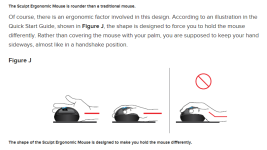This may be a problem with your wrist position and not with your finger or the mouse itself.
I recommend you check out the
Belkin Gel Wrist Pad. I love these things. I used to have lots of problems with sore wrists, sore hands and sore fingers - until I got one of these. Now I have one by all my computers. The only downside is on some desk surfaces, they slide. But that is easily remedied with a little double sided tape.
As seen via that link, they have a similar product for the keyboard. If your keyboard does not have a similar wrist rest, you might consider that too.
Even things like your chair height can affect the angle your wrists approach the keyboard and mouse. If not straight on, it can affect blood circulation and over time, increase strain and result is serious
RSI issues.
Last, you might try simply moving your mouse to the other side of your keyboard and start using your other hand. It will feel awkward at first but you will be surprised how quickly you will adapt. I am right handed but use my mouse with my left hand. I did that when carpel tunnel started giving me problems (years ago, before I discovered those pads). So I moved my mouse to the other side.
I actually discovered it made my computer work easier because I could do my mouse work with my left hand and use the numeric keypad part of my keyboard with the right.
But within a year, I started having carpel symptoms with my left hand too. A coworker suggested those pads and they worked. By that time, I was too used to using the mouse with my left so I have kept it on that side. That was over 10 years ago. No hand, wrist or finger pain since.
BTW, while hard to find, they have left-handed mice, where the the button functions are reversed. But instructions and tutorials always are written for the right handed and you would have to remember right click really means left click. Not worth it for me.
Universal (not contoured) mice are best IMO. Typical contoured mice are shaped [supposedly] for the right hand and may not feel right in the left. A "curved" keyboard like this "
Microsoft Comfort 5050 Keyboard and Mouse" set allows your arms to approach the keyboard
naturally from the sides where your shoulders are. A standard straight keyboard (including those on notebooks) force you to scrunch your wrists together which again can affect proper positioning.
That said, mice and keyboards are HIDs (human interface devices) that are extensions of our own hands. Therefore they are as individual as our own hands. What feels great to me may feel uncomfortable or even painful to you. So while others (including me) can offer suggestions for mice (and keyboards) these are things you really need to pick out for yourself. You need to visit your local computer stores and play touchy-feely with the display models. Try to position them at the same height as your desk and see/feel what feels good to you - just take some hand sanitizer with you!

And upnorth is right - this could be a medical issue that requires attention. You clearly need to make some changes, either with wrist support pads and/or a new mouse (and maybe keyboard) too. If those changes do not bring relief, you should see a doctor before permanent nerve damage occurs - assuming it has not already.

